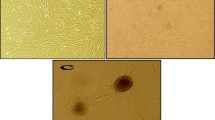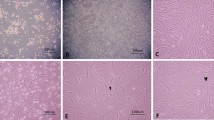Abstract
The ability to generate neural progenitor cells from human umbilical cord mesenchymal stem cells (hUC-MSCs) has provided an option to treat neurodegenerative diseases. To establish a method for this purpose, we characterized the early neural markers of hUC-MSCs-derived cells under different conditions. We found that neither the elimination of signals for alternative fate nor N2 supplement was sufficient to differentiate hUC-MSCs into neural precursor cells, but the GSK3 inhibitor SB216763 could promote an efficient neural commitment of hUC-MSCs. The results indicated that Wnt/β-catenin might play an important role during the early neural differentiation of hUC-MSCs. Here, we report a method for hUC-MSCs to commit efficiently into a neural fate within a short period of time. This protocol provides an efficient method for hUC-MSCs-based neural regeneration.






Similar content being viewed by others
Abbreviations
- hUC-MSCs:
-
Human umbilical cord mesenchymal stem cells
- GSK3:
-
Glycogen synthase kinase 3
- CNS:
-
Central nervous system
- NPCs:
-
Neural precursor cells
- FACS:
-
Fluorescence-activiated cell sorting
- ICC:
-
Immunocytochemistry
References
Abrams MB, Dominguez C, Pernold K, Reger R, Wiesenfeld-Hallin Z, Olson L, Prockop D. Multipotent mesenchymal stromal cells attenuate chronic inflammation and injury-induced sensitivity to mechanical stimuli in experimental spinal cord injury. Restor Neurol Neurosci. 2009;27:307–21.
Atlasi Y, Noori R, Gaspar C, Franken P, Sacchetti A, Rafati H, Mahmoudi T, et al. Wnt signaling regulates the lineage differentiation potential of mouse embryonic stem cells through Tcf3 down-regulation. PLoS Genet. 2013;9:e1003424.
Brederlau A, Correia AS, Anisimov SV, Elmi M, Paul G, Roybon L, Morizane A, et al. Transplantation of human embryonic stem cell-derived cells to a rat model of Parkinson’s disease: effect of in vitro differentiation on graft survival and teratoma formation. Stem Cells. 2006;24:1433–40.
Cananzi M, de Coppi P. CD117+ amniotic fluid stem cells state of the art and future perspectives. Organogenesis. 2012;8:77–88.
Chairoungdua A, Smith DL, Pochard P, Hull M, Caplan MJ. Exosome release of beta-catenin: a novel mechanism that antagonizes Wnt signaling. J Cell Biol. 2010;190:1079–91.
Chen H, Zhang Y, Yang Z, Zhang H. Human umbilical cord Wharton’s jelly-derived oligodendrocyte precursor-like cells for axon and myelin sheath regeneration. Neural Regen Res. 2013;8:890–9.
Chen Y, Guan Y, Liu H, Wu X, Yu L, Wang S, Zhao C, Du H, Wang X. Activation of the Wnt/β-catenin signaling pathway is associated with glial proliferation in the adult spinal cord of ALS transgenic mice. Biochem Biophys Res Commun. 2012;6:1–7.
Dasari VR, Veeravalli KK, Dinh DH. Mesenchymal stem cells in the treatment of spinal cord injuries: a review. World J Stem Cells. 2014;6:120–33.
Di J, Duiveman-de Boer T, Zusterzeel PLM, Figdor CG, Massuger LFAG, Torensma R. The stem cell markers Oct4A, Nanog and c-Myc are expressed in ascites cells and tumor tissue of ovarian cancer patients. Cell Oncol (Dordr). 2013;36:363–74.
Erceg S, Ronaghi M, Stojković M. Human embryonic stem cell differentiation toward regional specific neural precursors. Stem Cells. 2009;27:78–87.
Fhoov V, Duh DQG, Wr D, Wrzdugv G, Olqhdjhv P, Áxlg P, Pruh K, Ehhq U. Stem cells derived from amniotic fluid: new potentials in regenerative medicine. RBM Online. 2009;18:17–27.
Gurrieri C, Piazza F, Gnoato M, Montini B, Biasutto L, Gattazzo C, Brunetta E, et al. Displays therapeutic properties in a mouse model of Pulmonary inflammation and fibrosis. J Pharmacol Exp Therap. 2010;332:785–94.
Hassani Z, O’Reilly J, Pearse Y, Stroemer P, Tang E, Sinden J, Price J, Thuret S. Human neural progenitor cell engraftment increases neurogenesis and microglial recruitment in the brain of rats with stroke. PLoS One. 2012;7:e50444.
Huang H, Chen L, Sanberg P. Cell therapy from bench to bedside translation in CNS neurorestoratology era. Cell Med. 2011;1:15–46.
Iwakura T, Inui A, Reddi AH. Stimulation of superficial zone protein accumulation by hedgehog and wnt signaling in surface zone articular chondrocytes. Arthritis Rheum. 2014;65:408–17.
Jian R, Yixu Y, Sheyu L, Jianhong S, Yaohua Y, Xing S, Qingfeng H, et al. Repair of spinal cord injury by chitosan scaffold with glioma ECM and SB216763 implantation in adult rats. J Biomed Mater Res A. 2015;103:3259–72.
Kirby LA, Schott JT, Noble BL, Mendez DC, Caseley PS, Peterson SC, Routledge TJ, Patel NV. Glycogen synthase kinase 3 (GSK3) inhibitor, SB-216763, promotes pluripotency in mouse embryonic stem cells. PLoS One. 2012;7:e39329.
Leite C, Silva NT, Mendes S, Ribeiro A, De Faria JP, Santos F, Andrade PZ, et al. Differentiation of human umbilical cord matrix mesenchymal stem cells into neural-like progenitor cells and maturation into an oligodendroglial-like lineage. PLoS One. 2014;9:e111059.
Li L, Shao X, Cole EL, Ohnmacht SA, Ferrari V, Hong YT, Williamson DJ, et al. Synthesis and Initial in vivo studies with [(11)C]SB-216763: the first radiolabeled brain penetrative inhibitor of GSK-3. ACS Med Chem Lett. 2015;6:548–52.
Liu X, Li D, Jiang D, Fang Y. Acetylcholine secretion by motor neuron-like cells from umbilical cord mesenchymal stem cells. Neural Regen Res. 2013;8:2086–92.
Machon O, Backman M, Machonova O, Kozmik Z, Vacik T, Andersen L, Krauss S. A dynamic gradient of Wnt signaling controls initiation of neurogenesis in the mammalian cortex and cellular specification in the hippocampus. Dev Biol. 2007;311:223–37.
Ming-yuan H, Shi-qing F, Hui L, Chun-yuan W, Tie-qiang Y. Transplantation of human umbilical cord-derived mesenchymal stem cells for the treatment of spinal cord injury in rats. J Clin Rehabil Tissue Eng Res. 2010;14:3483–9.
Moschidou D, Mukherjee S, Blundell MP, Drews K, Jones GN, Abdulrazzak H, Nowakowska B, et al. Valproic acid confers functional pluripotency to human amniotic fluid stem cells in a transgene-free approach. Mol Ther. 2012;20:1953–67.
Munji RN, Choe Y, Li G, Siegenthaler JA, Pleasure SJ. Wnt signaling regulates neuronal differentiation of cortical intermediate progenitors. J Neurosci. 2011;31:1676–87.
Neuhuber B, Timothy Himes B, Shumsky JS, Gallo G, Fischer I. Axon growth and recovery of function supported by human bone marrow stromal cells in the injured spinal cord exhibit donor variations. Brain Res. 2005;1035:73–85.
Park TI-H, Monzo H, Mee EW, Bergin PS, Teoh HH, Montgomery JM, Faull RLM, Curtis MA, Dragunow M. Adult human brain neural progenitor cells (NPCs) and fibroblast-like cells have similar properties in vitro but only NPCs differentiate into neurons. PLoS One. 2012;7:e37742.
Parmar M, Li M. Early specification of dopaminergic phenotype during ES cell differentiation. BMC Dev Biol. 2007;7:4–6.
Piccolo S, Agius E, Leyns L, Bhattacharyya S, Grunz H, Bouwmeester T, De Robertis EM. The head inducer cerberus is a multifunctional antagonist of Nodal, BMP and Wnt signals. Nature. 1999;397:707–10.
Province H, Command GM, Province H. Induction and differentiation of umbilical cord mesenchymal stem cells into neuron-like cells by all- trans retinoic acid. 2015;8(2):250-6.
Rhee Y, Ko J, Chang M, Yi S, Kim D, Kim C, Shim J, et al. Protein-based human iPS cells efficiently generate functional dopamine neurons and can treat a rat model of Parkinson disease. 2011;121(6):2326–35.
Ronaghi M, Erceg S, Moreno-Manzano V, Stojkovic M. Challenges of stem cell therapy for spinal cord injury: human embryonic stem cells, endogenous neural stem cells, or induced pluripotent stem cells? Stem Cells. 2010;28:93–9.
Rosso SB, Inestrosa NC. WNT signaling in neuronal maturation and synaptogenesis. Front Cell Neurosci. 2013;7:103.
Sajini AA, Greder LV, Dutton JR, Slack JMW. Loss of Oct4 expression during the development of murine embryoid bodies. Dev Biol. 2012;371:170–9.
Shimizu T, Kagawa T, Wada T, Muroyama Y, Takada S, Ikenaka K. Wnt signaling controls the timing of oligodendrocyte development in the spinal cord. Dev Biol. 2005;282:397–410.
Smith JR, Pfeifer K, Petry F, Powell N, Delzeit J, Weiss ML. Standardizing umbilical cord mesenchymal stromal cells for translation to clinical use: selection of GMP-compliant medium and a simplified isolation method. Stem Cells Int. 2016;2016:e1–14.
Spring C. Stem cell biology. Cold Spring Harb Symp Quant Biol. 2008;73:479–90.
Szczepańska K, Stańczuk L, Maleszewski M. Oct4 protein remains in trophectoderm until late stages of mouse blastocyst development. Reprod Biol. 2011;11:145–56.
Tai M-H, Chang C-C, Kiupel M, Webster JD, Olson LK, Trosko JE. Oct4 expression in adult human stem cells: evidence in support of the stem cell theory of carcinogenesis. Carcinogenesis. 2005;26:495–502.
Tropepe V, Hitoshi S, Sirard C, Mak TW, Rossant J, van der Kooy D. Direct neural fate specification from embryonic stem cells: a primitive mammalian neural stem cell stage acquired through a default mechanism. Neuron. 2001;30:65–78.
Tsai C-C, Su P-F, Huang Y-F, Yew T-L, Hung S-C. Oct4 and Nanog directly regulate Dnmt1 to maintain self-renewal and undifferentiated state in mesenchymal stem cells. Mol Cell. 2012;47:169–82.
Valvezan AJ, Klein PS. GSK-3 and Wnt Signaling in neurogenesis and bipolar disorder. Front Mol Neurosci. 2012;5:1.
Wexler EM, Paucer A, Kornblum HI, Palmer TD, Geschwind DH. Endogenous Wnt signaling maintains neural progenitor cells potency. Stem Cells. 2009;27:1130–41.
Wiles MV, Johansson BM. Embryonic stem cell development in a chemically defined medium. Exp Cell Res. 1999;247:241–8.
Yao M, Bain G, Gottlieb DI. Neuronal differentiation of P19 embryonal carcinoma cells in defined media. J Neurosci Res. 1995;41:792–804.
Ying Q-L, Stavridis M, Griffiths D, Li M, Smith A. Conversion of embryonic stem cells into neuroectodermal precursors in adherent monoculture. London: Nature Publishing Group; 2003.
Yu J, Vodyanik MA, Smuga-Otto K, Antosiewicz-Bourget J, Frane JL, Tian S, Nie J, et al. Induced pluripotent stem cell lines derived from human somatic cells. Science (80). 2007;318:1917–20.
Zaminy A, Shokrgozar MA, Sadeghi Y, Norouzian M, Heidari MH, Piryaei A. Transplantation of schwann cells differentiated from adipose stem cells improves functional recovery in rat spinal cord injury. Arch Iran Med. 2013;16:533–41.
Zhang Z, Fu J, Xu X, Wang S, Xu R, Zhao M, Nie W, et al. Safety and immunological responses to human mesenchymal stem cell therapy in difficult-to-treat HIV-1-infected patients. AIDS. 2015;19:161–9.
Acknowledgments
We would like to express our gratitude to staffs of the Affiliated Hospital of Guangdong Medical Collage and the Clinical Research Center of Guangdong Medical College for the support and assistance in any circumstances related to this project. This study was supported by the Guangdong Medical Research Foundation (No. A2015483), the Zhanjiang Municipal Governmental Specific Financial Fund Allocated for Competitive Scientific and Technological Projects (No. 2014A06005), the Natural Science Foundation of Guangdong Province (No. S2013020012866), and the Innovation and Strengthening University Project of Guangdong Province (No. 4CX14111G).
Author information
Authors and Affiliations
Corresponding authors
Additional information
L. Gao, M. Zhao, P. Li and J. Kong contributed equally to this work.
An erratum to this article is available at http://dx.doi.org/10.1007/s13577-016-0152-8.
Electronic supplementary material
Below is the link to the electronic supplementary material.
13577_2016_146_MOESM1_ESM.tif
Supplementary Fig. 1: Immunophenotype and differentiation potential of hUC-MSCs. (A) FACS results showed that CD73, CD90, and CD105 were expressed in most of hUC-MSCs, but CD31, CD34, and CD45 were not detected in these cells. (B) hUC-MSCs could differentiate into adipocytes (Oil-red-O, i), chondroblasts (Alcian blue, ii), and osteoblasts (Alizarin red, iii). Bar, 500 μM (TIFF 529 kb)
Rights and permissions
About this article
Cite this article
Gao, L., Zhao, M., Li, P. et al. Glycogen synthase kinase 3 (GSK3)-inhibitor SB216763 promotes the conversion of human umbilical cord mesenchymal stem cells into neural precursors in adherent culture. Human Cell 30, 11–22 (2017). https://doi.org/10.1007/s13577-016-0146-6
Received:
Accepted:
Published:
Issue Date:
DOI: https://doi.org/10.1007/s13577-016-0146-6




